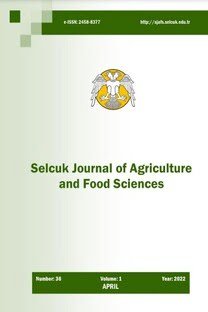Antibacterial effect of narince grape (vitis vinifera L.) pomace extract
üzüm, Vitis vinifera, antibakteriyel özellikler, fenolik bileşikler, meyve suyu ekstraksiyonu
Narince üzüm (vitis vinifera L.) cibresi extraktının antibakteriyal etkisi
___
- Ahn, H.S., Jeon, T.I., Lee, J.Y., Hwang, S.G., Lim, Y. and Park, K.P., 2002. Antioxidant activity of persimmon and grape seed extracts: in vitro and in vivo. Nutrition Research 22:1265-1273.
- Aureli, P., Costantini, A. and Zolea, S., 1992. Antimicrobial activity of some plant essential oils against Listeria monocytogenes. Journal of Food Protection 55:344-348.
- Basim, H., Yegen, O. and Zeller, W., 2000. Antibacterial effect of essential oil of Thymbra spicata L. var. spicata on some plant pathogenic bacteria. Journal of Plant Diseases and Protection 279(3):279-284.
- Baydar, H., Sagdiç, O., Özkan, G. and Karadogan, T., 2004. Antibacterial activity and composition of essential oils from Origanum, Thymbra and Satureja species with commercial importance in Turkey. Food Control 15: 169-172.
- Deans, S.G., Svoboda, K.P. and 1990. The antimicrobial properties of marjoram (Origanim majorana L.) volatile oil. Flavour and Fragrance Journal 5:187-190.
- Dorman, H.J.D. and Deans, S.G., 2000. Antimicrobial agents from plants: antibacterial activity of plant volatile oils. Journal of Applied Microbiology 88:308-316.
- Frankel, E.N., Kanner, J., German, J.B., Parks, E. and Kinsella, J.E., 1993. Inhibition of oxidation of human low-density lipoprotein by phenolic substances in red wine. The Lancet 341(20):454- 457.
- Göktürk Baydar, N., Özkan, G. and Sagdiç, O., 2003. Total phenolic contents and antibacterial activities of grape (Vitis vinifera L.) extracts. Food Control (in press).
- Ilçim, A., Digrak, M. and Bagci, E, 1998. The investigation of antimicrobial effect of some plant extract. Turkish Journal of Biology 22:119-125.
- Jayaprakasha, G.K., Singh, R.P. and Sakariah, K.K., 2001. Antioxidant activity of grape seed (Vitis vinifera) extracts on peroxidation models in vitro. Food Chemistry 73:285-290.
- Jayaprakasha, G.K., Selvi, T. and Sakariah, K.K., 2003. Antibacterial and antioxidant activities of grape (Vitis vinifera) seed extracts. Food Research International 36:117-122.
- Kivanç, M. and Akgül, A., 1986. Antibacterial activities of essential oils from Turkish spices and citrus. Flavour and Fragrance Journal 1:175-179.
- Mayer, A.S., Yi.Ock-Sook, Person, D.A., Waterhouse, A.L. and Frankel, E.N., 1997. Inhibition of human low-density lipoprotein oxidation in relation to composition of phenolic antioxidants in grapes (Vitis vinifera L.). Journal of Agricultural and Food Chemistry 45:1638-1643.
- Murthy, K.N.C., Singh, R.P. and Jayaprakasha, G.K., 2002. Antioxidant activity of grape (Vitis vinifera) pomace extracts. Journal of Agricultural and Food Chemistry 50:5909-5914.
- Oszmianski, J. and Lee, C.Y., 1990. Isolation and HPLC determination of phenolic compounds in red grapes. American Journal of Enology and Viticulture 39:259-62.
- Özcan, M. and Boyraz, N., 2000. Antifungal properties of some herb decoctions. European Food Research and Technology 212:86-88.
- Özcan, M. and Erkmen, O., 2001. Antimicrobial activity of the essential oils of Turkish plant spices. European Food Research and Technology 212:658-660.
- Özdamar, K., 1999. SPPS ile Bioistatistik ETAM A.S. Matbaa Tesisleri, Yayin No: 3, 454 s., Eskisehir.
- Özkan, G., Sagdiç, O. and Özcan, M., 2003. Inhibition on pathogenic bacteria by essential oils at different concentrations. Food Science and Technology International 9(2):85-88.
- Revilla, E. and Ryan, J.M., 2000. Analysis of several phenolic compounds with potential antioxidant properties in grape extracts and wines by high- performance liquid chromatography-photodiode array detection without sample preparation. Journal of Chromatography A 881:461-469.
- Ricardo da Silva, J. M., Rosec, J.-P., Bourzeix, M. and Heredia, N., 1990. Separation and quantitative determination of grape and wine prociyanidins by HPLC. Journal of the Science of Food and Agriculture 53: 85-92.
- Sagdiç, O., Kusçu, A., Özcan, M. and Özçelik, S., 2002. Effects of Turkish spice extracts at various concentrations on the growth of Escherichia coli O157:H7. Food Microbiology 19:473-480.
- Sagdiç, O. and Özcan, M., 2003. Antibacterial activity of Turkish spice hydrosols. Food Control 14:141- 143.
- Saito, M., Hosoyama, H., Ariga, T., Kataoka, S., and Yamaji, N., 1998. Antiulcer activity of grape seed extract and procyanidins. Journal of Agricultural and Food Chemistry 46:1460-1464.
- Shoko, T., Soichi, T., Megumi, M.M., Eri, F., Jun, K., and Michiko, W., 1999. Isolation and identification of an antibacterial compound from grape and its application to foods. Nippon Nogeikagaku Kaishi 73:125-128.
- Singleton, V.L., and Rossi, J.R., 1965. Colorimetry of total phenolics with Phosphomolibdic- phosphothungstic acid. American Journal of Enology and Viticulture 16:144-158.
- Somers, T. C. and Ziemelis, G., 1985. Spectral evaluation of total phenolic components in Vitis vinifera: grapes and wines. Journal of the Science of Food and Agriculture 36:1275-1284.
- Teissedre, P.L., Frankel, E.N., Waterhouse, A.L., Peleg, H. and German, J.B., 1996. Inhibition of in vitro human LDL oxidation by phenolic antioxidants from grapes and wines. Journal of the Science of Food and Agriculture 70:55-61.
- Wang, J.N., Chen, Y.J., Hano, Y., Nomura, T. and Tan, R.X., 2000. Antioxidant activity of polyphenols from seeds of Vitis amurensis in vitro. Acta Pharmacologica Sinica 21(7):633-636.
- Waterhouse, A.L., 1994. Wine antioxidants may reduce hearth disease and cancer. American Chemical Society. Washington D.C.
- ISSN: 1300-5774
- Yayın Aralığı: 3
- Başlangıç: 2018
- Yayıncı: Selçuk Üniv. Ziraat Fak.
Duran CİHAN, Elmalı Meryem UYSAL
SERTAÇ Güngör, MÜKERREM ARSLAN
OSMAN MURAT KOÇTÜRK, Necdet ÖZBİLGİN
Konya ilindeki zirai ilaç bayilerinin bazı yönlerden değerlendirilmesi1
Buğday ruşeymi ve fitaz ilavesiyle besin değeri yüksek yoğurt üretimi
Serpil YALÇINKAYA, Ahmet AYAR, Adem ELGÜN
EMİNE ATALAY, Suat GEZGİN, Mehmet BABAOĞLU
Hububat ekiminde tohum ve gübreyi farklı sıraya veren kombine ekim makinasının tasarımı
